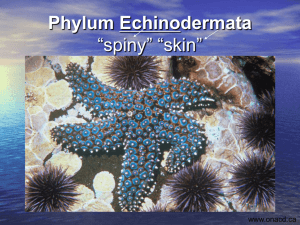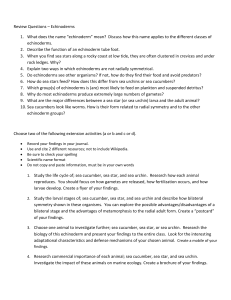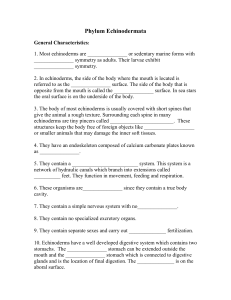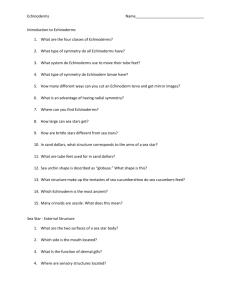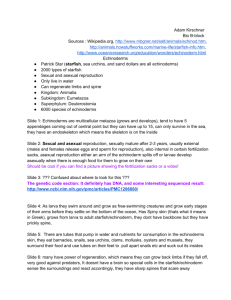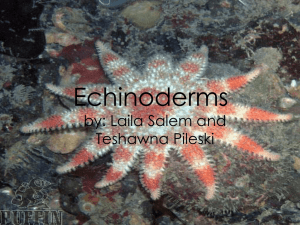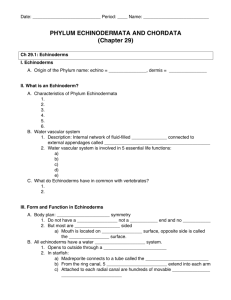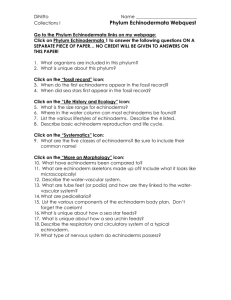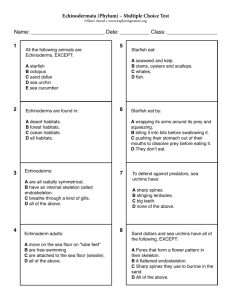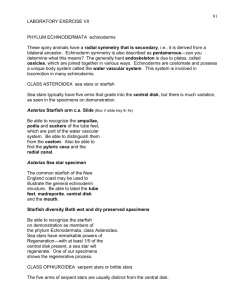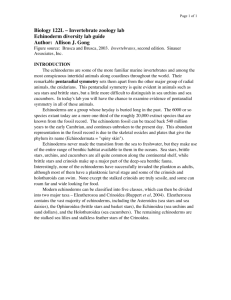Spiny-Skinned Animals - Fulton County Schools
advertisement
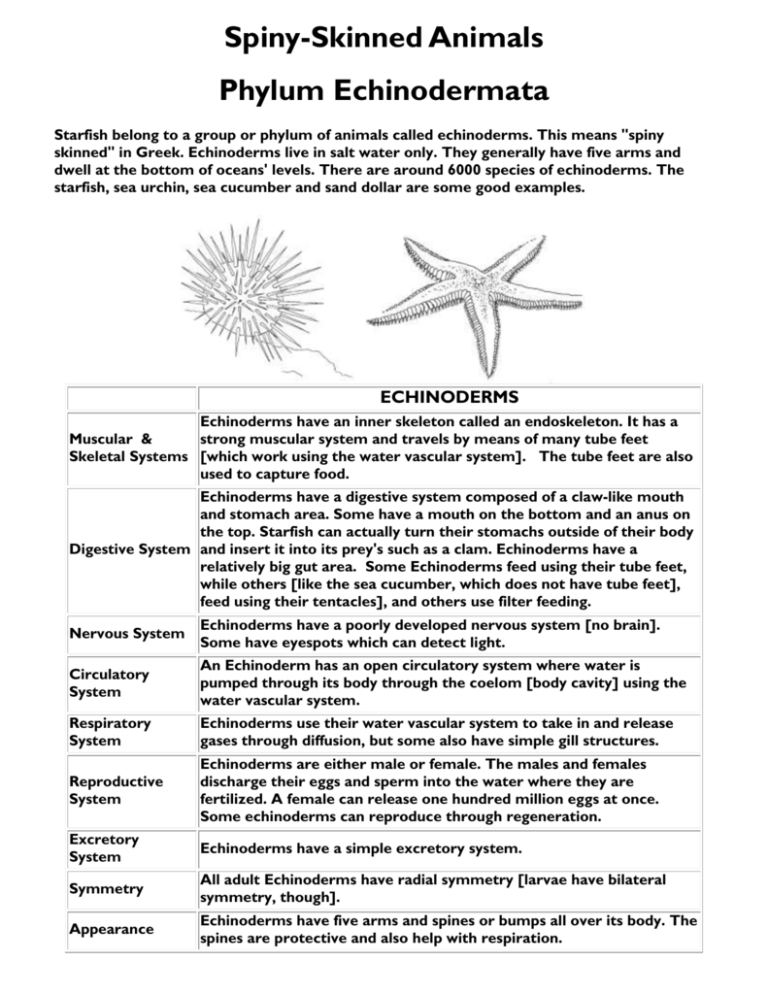
Spiny-Skinned Animals Phylum Echinodermata Starfish belong to a group or phylum of animals called echinoderms. This means "spiny skinned" in Greek. Echinoderms live in salt water only. They generally have five arms and dwell at the bottom of oceans' levels. There are around 6000 species of echinoderms. The starfish, sea urchin, sea cucumber and sand dollar are some good examples. ECHINODERMS Echinoderms have an inner skeleton called an endoskeleton. It has a Muscular & strong muscular system and travels by means of many tube feet Skeletal Systems [which work using the water vascular system]. The tube feet are also used to capture food. Echinoderms have a digestive system composed of a claw-like mouth and stomach area. Some have a mouth on the bottom and an anus on the top. Starfish can actually turn their stomachs outside of their body Digestive System and insert it into its prey's such as a clam. Echinoderms have a relatively big gut area. Some Echinoderms feed using their tube feet, while others [like the sea cucumber, which does not have tube feet], feed using their tentacles], and others use filter feeding. Nervous System Echinoderms have a poorly developed nervous system [no brain]. Some have eyespots which can detect light. Circulatory System An Echinoderm has an open circulatory system where water is pumped through its body through the coelom [body cavity] using the water vascular system. Respiratory System Echinoderms use their water vascular system to take in and release gases through diffusion, but some also have simple gill structures. Reproductive System Echinoderms are either male or female. The males and females discharge their eggs and sperm into the water where they are fertilized. A female can release one hundred million eggs at once. Some echinoderms can reproduce through regeneration. Excretory System Echinoderms have a simple excretory system. Symmetry All adult Echinoderms have radial symmetry [larvae have bilateral symmetry, though]. Appearance Echinoderms have five arms and spines or bumps all over its body. The spines are protective and also help with respiration. The purple sea urchin (Strongylocentrotus purpuratus) is a small sea urchin. It is a spiny, hard-shelled animal that lives on the rocky seafloor, from shallow waters to great depths. It is found off the west coast of North America, in the Pacific Ocean, from Canada to the Baja peninsula. It lives from the intertidal zone down to depths of about 33 feet (10 m). These globular marine invertebrates move very slowly along the seabed. Adult Anatomy: The purple sea urchin averages about 3 1/4 inches (8.5 cm) across; the spines are about 1/3 inch (1 cm) long. This bottom-dweller ranges from a light purple to a deep reddish-purple color (juveniles are green). Adult sea urchins have five-sided radial symmetry. Their skin has hard, chalky plates, and is called the test. Sea urchins have a globular body and long spines that radiate from the body. The spines are used for protection, for moving,and for trapping drifting algae to eat. Among the spines are five paired rows of tiny tube feet with suckers that help with locomotion, capturing food, and holding onto the seafloor. Tiny pedicellarines are small stinging structures that are used for defense and for obtaining food. Like all echinoderms, sea urchins do not have a brain. The mouth is claw-like and is located on the underside; it has 5 tooth-like plates that point inwards and are called Aristotle's lantern. The anus and the genital pores are on the top of the sea urchin. Diet: Sea urchins eat plant and animal matter, including kelp, decaying matter, algae, dead fish, sponges, mussels, and barnacles. Predators of Sea Urchins: Sea urchins are eaten by crabs, sunflower stars, snails, sea otters, some birds, fish, and people. Reproduction: Fertilization is external. Female Sea Urchins release several million tiny, jelly-coated eggs at a time. Eggs or sperm are released through five gonopores. As they develop, the tiny larvae (called the pluteus, which have bi-lateral symmetry) swim in the sea and are a component of zooplankton. It takes several months for juvenile sea urchins to form. The time from fertilization to a reproductive adult is from 2 to 5 years. Classification: Kingdom Animalia (animals), Phylum Echinodermata (echinoderms), Class Echinoidea (Sea Urchins), Order Echinoida, Family Strongylocentrotidae, Genus Strongylocentrotus, Species S. purpuratus (it was named by Stimpson in 1857). Sea stars (also known as starfish) are spiny, hard-skinned animals that live on the rocky sea floor. These invertebrates are NOT fish; they are echinoderms. Sea stars move very slowly along the sea bed, using hundreds of tiny tube feet. There are over 2,000 different species of sea stars worldwide. Reproduction: Most species of starfish expel enormous numbers of eggs and sperm into the ocean; fertilization is external. After fertilization, the tiny, transparent, bilaterally-symmetrical larvae (baby sea stars) travel many miles as they are swept along by ocean currents for about two months. As they develop, the tiny larvae swim in the sea, eat phytoplankton, and are a component of zooplankton. Diet: Sea stars are carnivores (meat-eaters). They eat clams, oysters, coral, fish, and other animals. They push their stomach out through their mouth (located on the underside of the sea star) and digest the prey. Anatomy: Most sea stars have five arms (or a multiple of five) that radiate from a central disk. Sea stars do not have a brain; they have a simple ring of nerve cells that moves information around the body. Eyespots (primitive light sensors) are at the tip of each arm. If a sea star's arm is cut off, it will regenerate (regrow). Classification: Kingdom Animalia (animals), Phylum Echinodermata (echinoderms), Class Asteroidea (sea stars), about 2,000 species. Sea cucumbers (Class Holothuroidea) are cylinder-shaped invertebrate animals that live in seas worldwide. They are found in a variety of sea floor habitats, from warm tropical waters to cold deep sea trenches. These nocturnal animals have a life span of about 5 to 10 years. Anatomy: The body of the sea cucumber is elongated, leathery and muscular; spines are contained with the skin. These echinoderms have no arms, but do have five-part symmetry. Surrounding the mouth are 8 to 30 tentacles (modified tube feet). Five double rows of tube feet (with tiny suction cups) run along the body; they are used for crawling along the sea bed or anchoring to a rock. A sea cucumber breathes by pumping sea water in and out of an internal organ called a respiratory tree. Some sea cucumbers burrow into the sea floor. Sea cucumbers have no brain. The biggest sea cucumber, the tiger's tail sea cucumber (Holothuria thomasi), is about 2 m long - most sea cucumbers are much smaller than this. Diet: Sea cucumbers eat decaying matter that floats in the water or is in the sand. Enemies: Sea turtles, crustaceans, many fish, and people eat sea cucumbers. Interesting fact: Sea cucumbers can expel most of their internal organs to confuse predators - they later regrow the organs. Some sea cucumbers' bodies contain toxins that can deter attackers. Reproduction: Eggs and sperm are broadcast (released) into the water (the sexes are separate). When an egg is fertilized and hatches, the tiny larva drifts with the ocean currents. It will eventually settle onto the sea floor and develop into an adult. Classification: Kingdom Animalia (animals), Phylum Echinodermata (echinoderms), Subphylum Asterozoa (=Eleutherozoa - sea cucumbers, sea urchins, sand dollars, sea stars, brittle stars, and basket stars). Class Holothuroidea (sea cucumbers), about 900 species
